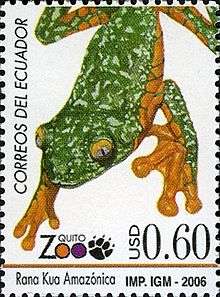Cruziohyla craspedopus
Cruziohyla craspedopus, the fringed leaf frog[1][2] or fringed tree frog,[3] is a species of frog in the family Phyllomedusidae,[1][2][3] alternatively treated as the subfamily Phyllomedusinae of the family Hylidae.[4] It is found in the Amazonian lowlands in Brazil, Colombia, Ecuador, and Peru, and possibly in Bolivia.[2]
| Fringe tree frog | |
|---|---|
 | |
| Scientific classification | |
| Kingdom: | Animalia |
| Phylum: | Chordata |
| Class: | Amphibia |
| Order: | Anura |
| Family: | Phyllomedusidae |
| Genus: | Cruziohyla |
| Species: | C. craspedopus |
| Binomial name | |
| Cruziohyla craspedopus (Funkhouser, 1957) | |
| Synonyms[2] | |
| |
Description
Adult males measure 53–66 mm (2.1–2.6 in) and adult females 68–76 mm (2.7–3.0 in) in snout–vent length. The head is slightly wider than it is long. The snout is sharply truncate in lateral view. The fingers and toes are webbed. The hind margin of the tarsus bear extensive dermal appendages forming irregular spurs. The dorsum has uniform dark green dorsal background coloration interspersed with irregular-shaped large pale blue-grey lichenose blotches. The flanks have narrow black lines. The undersides and concealed surfaces of the flanks and legs are yellow.[3]
Habitat and conservation
Cruziohyla craspedopus is a high-canopy frog of primary tropical lowland rainforest at elevations of 50–600 m (160–1,970 ft) above sea level. It only descends to lower branches for breeding, which takes place in fallen trees holding small water pools. However, tadpoles have also been found in small pools on the ground.[1]
Cruziohyla craspedopus is a rare species. It is not facing major threats, but it can locally suffer from habitat loss caused by human activities (e.g., agriculture). It occurs in several protected areas such as the Yasuni National Park in Ecuador and the Manú National Park in Peru.[1]
References
- Angulo, A.; Coloma, L.A.; Ron, S.; Hoogmoed, M.; Castro, F.; Rueda, J.V.; Cisneros-Heredia, D. & Monteza, J.I. (2004). "Cruziohyla craspedopus". IUCN Red List of Threatened Species. 2004: e.T55291A86444116. doi:10.2305/IUCN.UK.2004.RLTS.T55291A11275223.en.{{cite iucn}}: error: |doi= / |page= mismatch (help)
- Frost, Darrel R. (2019). "Cruziohyla craspedopus (Funkhouser, 1957)". Amphibian Species of the World: an Online Reference. Version 6.0. American Museum of Natural History. Retrieved 25 January 2019.
- Gray, Andrew R. (2018). "Review of the genus Cruziohyla (Anura: Phyllomedusidae), with description of a new species". Zootaxa. 4450 (4): 401–426. doi:10.11646/zootaxa.4450.4.1. PMID 30313830.
- "Cruziohyla craspedopus". AmphibiaWeb. University of California, Berkeley. 2019. Retrieved 25 January 2019.
| Wikimedia Commons has media related to Cruziohyla craspedopus. |
